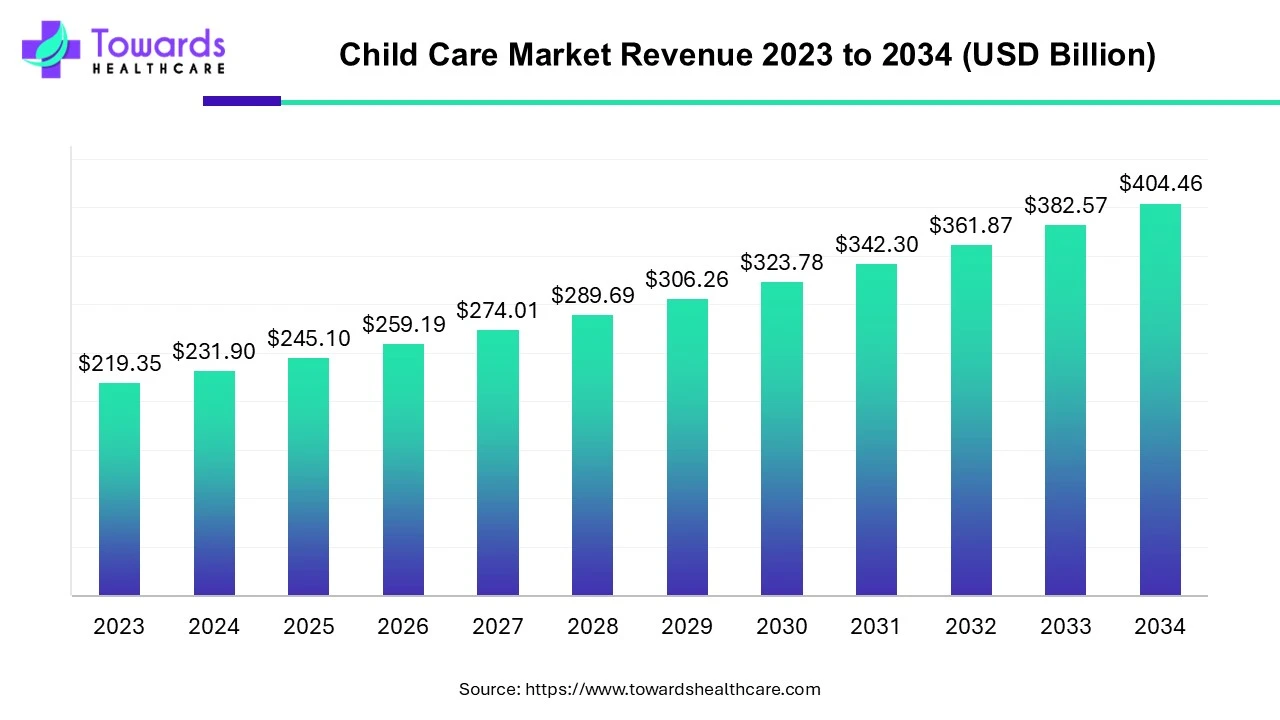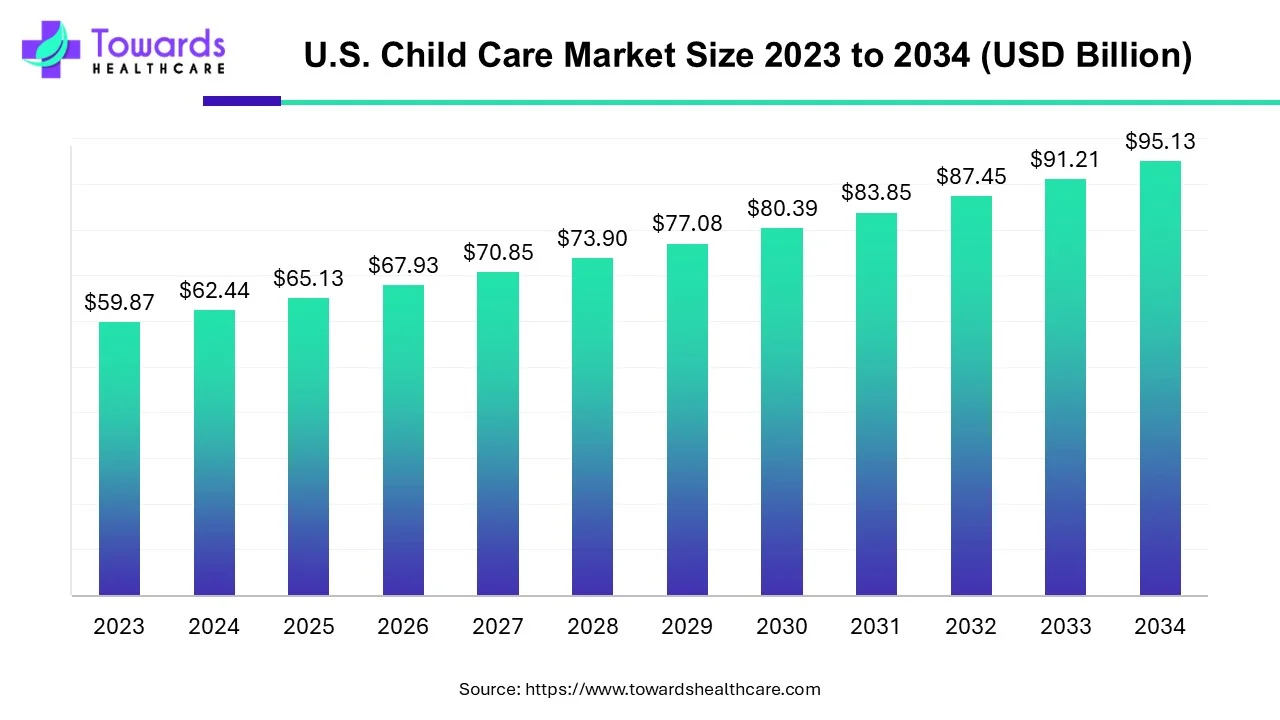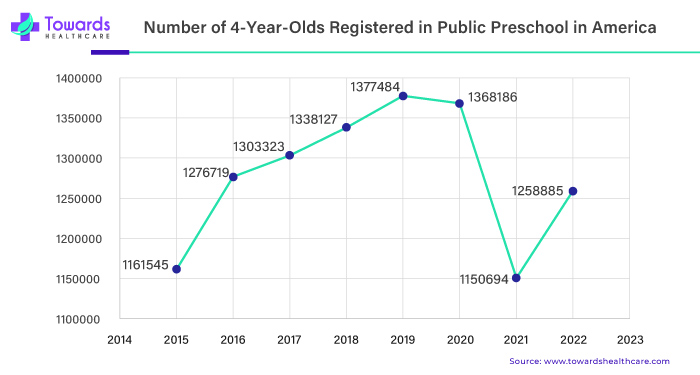The global child care market is valued at US$ 245.10 billion in 2025 and is expected to reach US$ 404.46 billion by 2034, growing at a CAGR of 5.72% between 2024 and 2034.

The U.S. child care market size is anticipated to grow from USD 65.13 billion in 2025 to USD 95.13 billion by 2034, with a compound annual growth rate (CAGR) of 4.3% during the forecast period from 2025 to 2034.

According to Scottish Government estimates, the number of registrations for funded Early Learning Child Care (ELC) increased by 8.6% in 2022, from 6,459 in 2021 to 7,017 in 2022, as the number of working parents has increased and the demand for child care services has risen.
Child care involves caring for children when their parents or guardians are unavailable. It goes beyond just keeping an eye on them – it includes providing a safe and nurturing environment where children can play, learn, and grow. U.S. child care can occur in daycare centers, preschools, or at home with a babysitter. The goal is to support the child's development, ensuring they are happy, healthy, and learning new things while their parents are away.
The U.S. child care market is a dynamic and vital component of the nation's social infrastructure. With a growing emphasis on early childhood education and the increasing number of working parents, the demand for quality child care services has surged in recent years. This blog aims to provide a comprehensive overview of the U.S. child care market, exploring key trends, challenges, and opportunities that define this intricate ecosystem. To understand the present, it's essential to delve into the past. The history of child care in the U.S. reveals a gradual evolution from informal, community-based arrangements to the structured, regulated systems today. From the humble beginnings of neighborhood babysitters to the emergence of day-care centers, tracing this trajectory offers insights into societal shifts and changing family dynamics.
More girls attend school, stay longer, and do well, but some still face challenges like dropping out of early marriages and pregnancies. As they grow up, taking care of their family often makes it challenging for them to pursue higher education or work. Globally, many women can't work due to unpaid care duties. This hurts girls and whole countries. Sadly, lots of families lack good child care. The World Bank says 40% of young kids (350 million) need child care but can't get it. If we improve child care, it can benefit girls, families, businesses, and economies.
When the study kicked off, there was a bit of debate among the researchers about what exactly to label as "child care." Some thought regular care from the father should count, while others argued that only care from non-parental figures should be included. After some discussion, they decided to encompass all consistent care provided by someone other than the mother. This covered care from relatives, a single caregiver in the child's home, small group care at a caregiver's place, and center-based care. Most of the info here focuses on the early years, up to age 4. Once kids hit 5 and start school, their child care landscape shifts. The researchers should have delved into the experiences of school-aged children in this study.
Additionally, these findings are interesting because they help us understand the different types of child care kids receive. It's essential to consider these aspects, especially as the global market grows, impacting how families structure child care for their little ones.
Benefits of Family Child Care Center
Family U.S. child care centers have advantages like keeping kids of different ages from the same family together all day. Also, the children and the caregiver might have a shared cultural or language connection. These care setups are more accessible in areas where regular child care options are scarce, which is the case in more than half of the country. This model fits many families based on their needs and priorities.

The increasing awareness of early childhood education plays a pivotal role in driving the demand for the U.S. child care market. As individuals gain a deeper understanding of the vital impact early learning has on a child's overall development, there is a rising emphasis on the need for high-quality child care services.
For Instance,
Parents and caregivers are now more cognizant of the significance of creating a stimulating and educational environment for young children. This heightened awareness directly translates into a surge in the demand for child care services that go beyond merely providing a safe and nurturing space. The emphasis is now on seeking out facilities that actively incorporate early education into their programs.

In simpler terms, the growing recognition of the importance of early childhood education prompts individuals to actively search for childcare providers aligned with these educational objectives. This heightened awareness becomes a driving force behind the expansion of the U.S. child care market, as parents actively pursue services that prioritize their child's learning and developmental needs during these crucial early years.
In 2022, the Annie E. Foundation's KIDS COUNT, with more parents marrying later, lower marriage rates, and increased divorces, nearly one in three kids (around 24 million) in the U.S. live in single-parent families. Most live with single moms, and there's a rise in those with cohabiting parents. The demand for child care is also increasing due to high investment and more working parents. Different racial and ethnic groups show variations, with Black and American Indian kids more likely in single-parent families, while White and Asian/Pacific Islander kids are less likely. Family nativity plays a role, with U.S.-born kids having a higher percentage in single-parent households.

Giving kids excellent and affordable child care helps them do well in school and beyond. But it's crucial that the child care is top-notch – not just any will do, and bad quality can be harmful. Countries need to spend wisely and make sure child care staff are well-trained. Quality child care has lots of benefits. It prepares kids for school, lowers their chances of repeating grades or quitting, and boosts their success. Good child care also keeps kids safe and can provide other health services. For example, in rural Bangladesh, community-based child care reduced deaths, including accidents. There's also proof that being in child care helps with nutrition. In Guatemala, kids in child care eat healthier, with more protein, iron, and vitamin A. Making quality child care available and affordable is an innovative and practical investment for countries. It builds up kids, promotes fairness, and empowers women economically. It's a win-win!
Imagine you have a little explorer at home and want them to have a great time learning and playing with other kids. Now, think of this place as a superhero school – the teachers are superheroes, ensuring everything is safe, fun, and educational. But here's the tricky part: sending your little hero to this superhero school can be expensive. It's like buying a ticket to a fantastic theme park – it puts a big dent in your pocket. This high cost is a challenge for many families. It's like saying, "Come on, superheroes, join the adventure, but it'll cost you a lot." It is challenging for some families to send their little heroes to these fantastic schools. Now, let's dig a bit deeper into why this happens. The superhero school needs funds for everything – from cool toys to safe spaces and, of course, the superheroes themselves (the teachers!). Sometimes, these costs add up, making it hard for the superhero school to keep the ticket prices low. But don't worry; we can find ways to make it more affordable so that every little hero can enjoy the fun.
The superheroes who take care of our little explorers – the teachers. Imagine there's a superhero school, but there aren't enough superheroes to guide the little heroes. That's the challenge we call workforce shortages. It's like having a party without enough hosts to ensure everyone has a good time. So, why does this happen? Being a superhero teacher is a super important job, but it's not always easy. Sometimes, not enough people become superheroes because they need special training and support. And when there aren't enough superheroes, it's tough for superhero schools to open doors to all the little heroes.
We can fix this too! We can help more people become superhero teachers by giving them the right training and ensuring they're happy in their jobs. The government can join in like a superhero team-up by creating programs to encourage more people to become superhero teachers. This way, our superhero schools will have plenty of superheroes to guide our little heroes, and the adventure can continue for everyone. In a nutshell, making superhero schools more affordable and ensuring there are enough superhero teachers are like solving puzzles to create a fantastic world where every little hero can learn, play, and grow – without any barriers or challenges holding them back!

Early childhood poverty casts a long shadow, with research showing its lasting negative impact on health and development, even in infants. This burden falls disproportionately on young children, who hold the dubious title of "poorest age group" in the US. In 2022, nearly 16% of under-6s lived in poverty, with rates almost doubling for this age group compared to the previous year. While the official poverty line defines a family of four with two children as "poor" if they earn less than $29,678 annually, the reality paints a starker picture, with the supplemental poverty measure revealing a true rate closer to 13%. This alarming trend demands immediate action to address the root causes of childhood poverty and ensure all children have the opportunity to thrive. Thus, young children, who are already disproportionately affected by poverty, have limited access to adequate daycare due to its high cost. This lack of access impedes their cognitive, social, and emotional development, continuing the cycle of adversity.
The U.S. child care market has various providers, from small home-based daycares to large child care centers. Urban areas often have a higher concentration of facilities, while rural areas may need help in access. State regulations also play a significant role in shaping the landscape, impacting licensing requirements and program standards. Additionally, socioeconomic factors influence demand and affordability, affecting the distribution of child care services across different regions of Open Menu.
The U.S. child care market is competitive, comprising a mix of large national chains, regional providers, and smaller independent centers. Competition often centers around program quality, safety standards, and educational offerings. Market dynamics vary by location, with urban areas witnessing more intense competition due to higher demand. Pricing strategies, convenience, and additional services such as early education programs also impact competitiveness. State regulations influence entry barriers and operational standards, contributing to the competitive landscape. The ongoing trend towards incorporating technology in child care services further adds a dimension to competition in the evolving market.
For Instance,

By Application
By Service Type
By Age Group
By Region
December 2025
December 2025
December 2025
December 2025